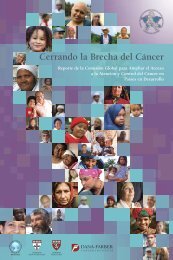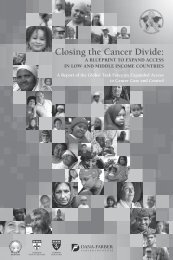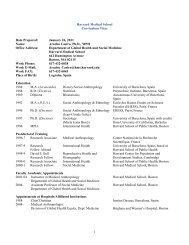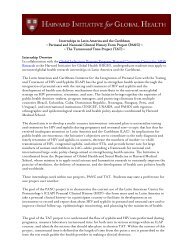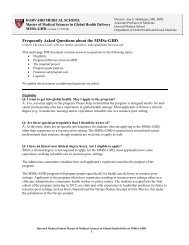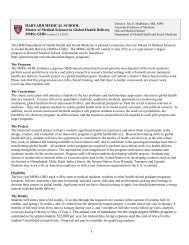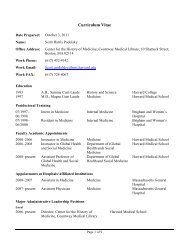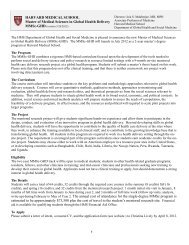Haiti Case Study - The Department of Global Health and Social ...
Haiti Case Study - The Department of Global Health and Social ...
Haiti Case Study - The Department of Global Health and Social ...
You also want an ePaper? Increase the reach of your titles
YUMPU automatically turns print PDFs into web optimized ePapers that Google loves.
the USNS COMFORT was based largely on resource considerations. Thus, once earthquakerelated<br />
injuries levelled <strong>of</strong>f <strong>and</strong> the non-earthquake related injured <strong>and</strong> ill began seeking<br />
care from COMFORT 137 , the ship began a tacit program <strong>of</strong> “weaning,” whereby fewer <strong>and</strong> fewer<br />
patients were accepted, even though COMFORT had additional capacity. COMFORT left on 09<br />
March 2010 138 , 49 days after she treated her first patients.<br />
DISCUSSION<br />
30. Existing health facilities—already struggling to meet the needs <strong>of</strong> the population—were<br />
devastated by the earthquake, especially at the secondary <strong>and</strong> tertiary care levels.<br />
Hospitals, where they survived, were rapidly overwhelmed by patients. Military security <strong>and</strong><br />
military medical treatment facilities were used to temporarily strengthen the health system<br />
<strong>and</strong> clearly provided net benefit to the <strong>Haiti</strong>an population <strong>and</strong> in the immediate aftermath <strong>of</strong><br />
the disaster.<br />
31. <strong>The</strong>re were however some challenges faced by those providing security at existing<br />
medical treatment facilities <strong>and</strong> those working at military hospitals. It is worth noting that<br />
both military health facility providers considered in this narrative, although operating very<br />
different facilities <strong>and</strong> from different nations under different m<strong>and</strong>ates, faced similar<br />
challenges. Many <strong>of</strong> these challenges were also faced by NGOs operating treatment<br />
facilities. <strong>The</strong> following sections sum up the challenges faced.<br />
Military security provision at indigenous health facilities<br />
32. Initially, security did not appear to be a major concern on the ground: <strong>Haiti</strong> was not<br />
involved in armed conflict at the time <strong>of</strong> the earthquake. <strong>The</strong> immediate-post-shock stage<br />
affected everybody universally, an idea corroborated, for instance, by statistical data with<br />
respect to gunshot wound interventions in MSF facilities; there were about the half as many<br />
in the first month following the earthquake than in the following months. 139 As a<br />
consequence, there was no evidence <strong>of</strong> civil unrest outbreak <strong>and</strong> no particular report <strong>of</strong><br />
violence against health facilities. 140 Due to the lack <strong>of</strong> coordination <strong>and</strong> the absence <strong>of</strong> police<br />
forces during the first days, a military presence was helpful to secure the healthcare facilities<br />
<strong>and</strong> allow service providers the opportunity to triage casualties, until transition to local police<br />
or private security could be arranged.<br />
Building situation awareness <strong>and</strong> coordinating<br />
33. <strong>The</strong> early responders from the international community had to set up their facilities<br />
without coordination or st<strong>and</strong>ardization. At the outset, newly-arrived responding healthcare<br />
providers simply did not know what <strong>Haiti</strong>an (or pre-existing non-<strong>Haiti</strong>an) healthcare facility<br />
capabilities existed—they did not have comprehensive knowledge <strong>of</strong> what prior capabilities<br />
had existed to begin with <strong>and</strong> they did not know the current status <strong>of</strong> those capabilities. An<br />
assessment <strong>of</strong> the status <strong>of</strong> existing capabilities is required for any provider seeking to<br />
integrate with existing efforts. US military providers seemed to have among the best<br />
situation awareness in this respect following extensive pre-deployment surveys. Some<br />
private sector care providers sent personnel with h<strong>and</strong>held (e.g. Blackberry, Palm Pilot, etc.)<br />
communication devices to get data <strong>and</strong> develop a database <strong>of</strong> needs <strong>and</strong> capabilities. It<br />
seems that little information sharing took place in the early days <strong>and</strong> at least one observer<br />
felt this ad hoc effort to create a common operating picture ultimately took too long to set up.<br />
“By the time it could be up <strong>and</strong> running, need was over”, one US Government representative<br />
said.<br />
34. One surprising but undeniable feature <strong>of</strong> the effort to coordinate <strong>and</strong> st<strong>and</strong>ardize efforts<br />
<strong>and</strong> build situation awareness was the role <strong>of</strong> personal knowledge <strong>and</strong> informal contacts<br />
among key players. Military contributions benefitted significantly from the ad hoc capability<br />
provided by informal contacts. It seems likely there will be a lack <strong>of</strong> coordination <strong>and</strong><br />
st<strong>and</strong>ardization to cope with at the start <strong>of</strong> any crisis response <strong>and</strong> informal contact networks<br />
are a pragmatic solution to overcome this challenge <strong>and</strong> should be encouraged.<br />
B-6



